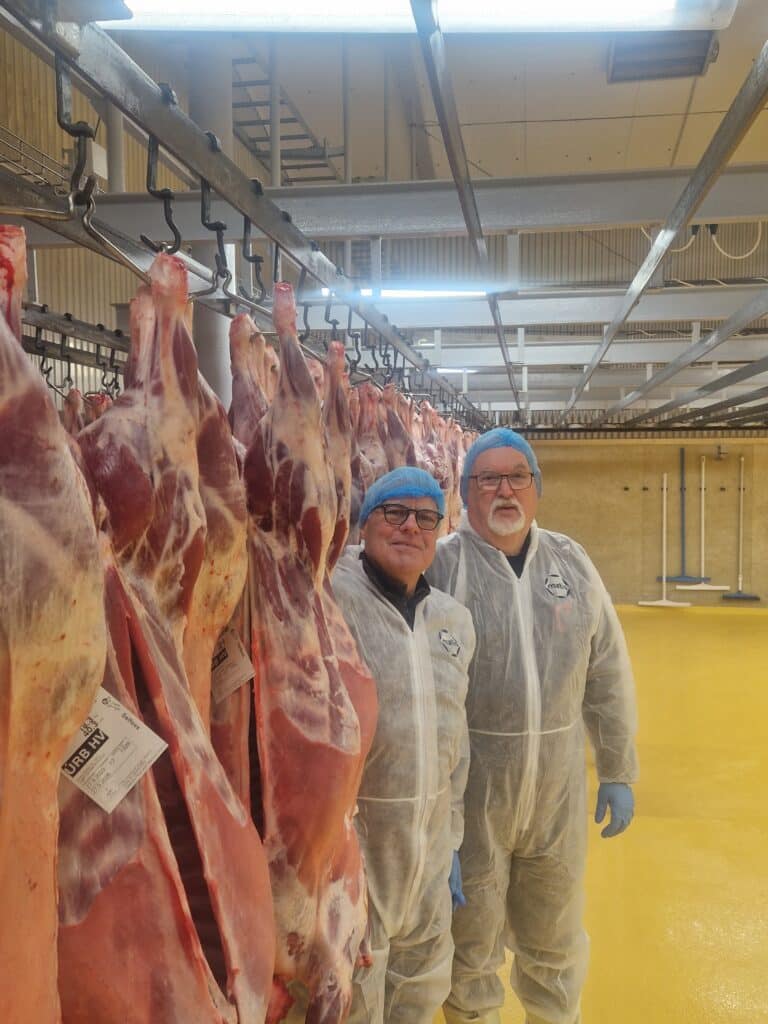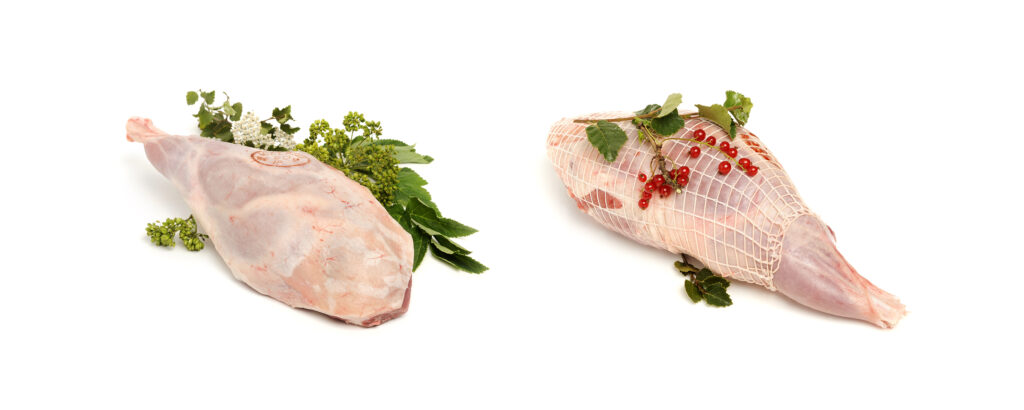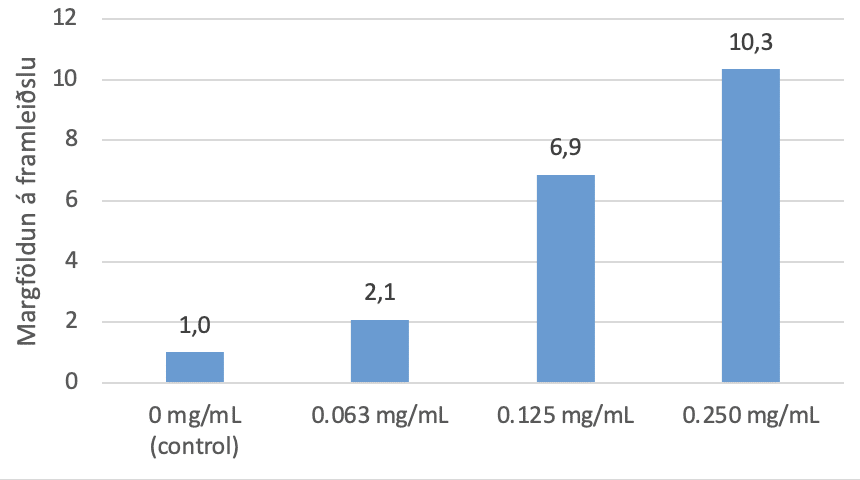The study aimed to evaluate the effects of onboard refrigerated seawater (RSW) storage of whole ungutted cod on the quality parameters of fillets. The reference group was directly gutted, bled, and stored in ice, while three experimental groups were gill-cut, bled, and stored ungutted in an onboard RSW tub at −1.5°C for 24, 60, and 84 hours. The results showed a difference between groups with extended RSW storage leading to negative effects such as increased gaping, bile spots, TVB-N levels, and bacterial growth after 60 hours. Conversely, the 24-hour RSW group closely resembled the quality parameters of the reference group.
Author: Kristín Edda Gylfadóttir
Seaweed is becoming a popular food source due to its high nutritional content, but may also contain potentially toxic elements (PTEs). This study investigates trends in PTEs in several species of seaweed collected in Iceland, and variations between thallus section, location, and season. As (3.8-265 mg kg-1), Cd (0.06-18 mg kg-1) and U (0.03-1.9 mg kg-1) were highest in Phaeophyta collected in February, whilst certain Chlorophyta contained the highest levels of Pb ( 0.02-1.8 mg kg-1) and Fe (25-13607 mg kg-1). Samples contained high levels of essential trace elements but elevated levels of Cd – 19 samples exceeded the maximum level (3 mg kg-1) in food supplements. As levels were also high where over half of samples exceeded the 40 mg kg-1 ML for As in seaweed-derived animal feed. Certain species grown in Iceland may be prone to high levels of Cd and not be suitable for consumption in large quantities.
The short harvesting period of cultivated brown seaweed in Europe can make it difficult for cultivators to produce high quality seaweed biomass all year round. Hence there is a need for novel processing and preservation methods. Acid preservation is a well-known method to preserve food, where the aim is to reduce the pH below 4.5 to inhibit microbial growth. To evaluate the effectiveness of acid preservation, a shelf-life experiment was conducted with Saccharina latissima and Alaria esculenta. The biomass was either treated with lactic or citric acid and stored for approximately seven months. Physicochemical (including proximate composition, trace minerals, total phenolic content (TPC), texture and pH), microbial-, sensory attributes, and antioxidant (ORAC, DPPH) analyzes were performed on the preserved biomass during storage. The proximate composition, color, pH, and texture of the acid-preserved seaweed were relatively stable throughout the storage. However, a decrease was observed in TPC and antioxidant properties (assessed by DPPH) with the acid treatments. Acid preservation is, thus, a good method to stabilize the studied biomass for food and feed applications, but less applicable if intended for antioxidant purposes. However, the acid treated biomass might be suitable as an ingredient for a wide range of value-added products.
Atlantic herring Clupea harengus feeding in the Norwegian Sea are assumed to consist of Norwegian spring spawners (NSSH), Icelandic summer spawners (ISSH) and North Sea autumn spawners (NSAH). Putative Norwegian autumn spawners (NASH), Faroese autumn (FASH) and spring (FSSH) spawners also feed in the area.
However, until there is a method to discriminate between populations in mixed samples, fishery and survey data from the Norwegian Sea will be solely attributed to the predominating NSSH, ultimately causing biased stock assessments.
Hence, we evaluated if a panel of 120 single nucleotide polymorphisms (SNPs) associated with spawning characteristics and salinity preferences would be an effective discrimination tool. The overall observed levels of genetic differentiation were high (FST = 0.57, p < 0.001, 95% CI: 0.51−0.62). Spawners from stocks under current management (NSSH, NSAH and ISSH) were well separated, but the putative populations were not. Discriminant analysis of principal component as well as Structure runs confirmed the differentiation observed with FST. When the SNP panels were tested on commercial fishery samples of NSSH east of Iceland, up to 16% were assigned to ISSH.
This implies that catch data are seriously biased and demonstrates the potential of SNP panels as a tool to solve the problem. However, work is needed to develop improved SNP panels that effectively separate the putative populations from the managed stocks. We recommend that such a tool should be established in regular sampling of fisheries and surveys in the Norwegian Sea and accounted for in future stock assessments, advice and management.
Dietary vitamin B12 deficiency is one of the most common micronutrient deficiencies worldwide, with over a billion individuals suffering from low levels of the vitamin. While ruminant-derived meat and dairy products play a crucial role in providing the recommended B12 dietary allowance (2.4 μg/day), increasing the production and consumption of meat and milk entails substantial environmental ramifications.
Spirulina blue-green algae (Arthrospira platensis) has been widely proposed as healthier and more sustainable substitutes for meat, milk, and dairy products (also known as meat and milk analogues). However, previous research has shown that while Spirulina contains desirable macro- and micro-nutrients (eg, essential amino acids, calcium, potassium, magnesium, iron), the majority of vitamin B12 found in so-called traditional Spirulina is a non-active , pseudo-form (cobamide), unavailable to humans, referred to as pseudo-vitamin B12. This renders traditional Spirulina a limited alternative to animal-source foods. As a response, in this exploratory in vitro study, we ask whether light conditions may enhance active vitamin B12 production in Spirulina.
We describe the use of scalable photobioreactors, artificially illuminated, located in the Hengill area of Iceland. These systems are used to cultivate Photosynthetically Controlled Spirulina (PCS), to produce carbon–neutral and nutritious biomass containing unopposed, biologically active vitamin B12, in levels comparable to beef (1.64 μg/100g in PCS with a standard deviation of 5% versus 0.7– 1.5 μg/100g in beef). In terms of mitigating global vitamin B12 deficiency, we explore production scale up scenarios.
In one scenario, by re-allocating the electricity currently consumed by heavy industry, Iceland could produce 277,950 tonnes of Spirulina biomass per year, which translates into approximately 4555 g per year of active vitamin B12, able to meet the recommended dietary allowance ( RDA) of over 13.8 million children aged 1–3. More ambitious production scenarios could see Iceland providing the RDA for over 26.5 million children aged 1–3, and over 50 million children aged 0–6 months.

Matís and RISE from Sweden will bring together experts in the field of bioeconomy in a workshop called "BIO2REG expert workshop on research infrastructure and living labs" on September 5th and 6th next in Matís' house in Reykjavík.
In the workshop, projects related to bioeconomies, the development of the last decades and the importance of green energy will be reviewed. National and foreign experts will speak, as well as field visits to selected companies in the capital area and the surrounding area.
The workshop is open to everyone and free of charge.
A registration link along with further information and program drafts can be found here:


At Matís, we work on diverse research and development projects on meat in collaboration with producers and various stakeholders. The goal is to strengthen domestic meat production and promote value creation. Recently, a project funded by the Food Fund and entitled Discection yields and nutrient value of Icelandic lamb meat and organs and was won by Matís and the Icelandic lamb marketing agency.
The project was carried out in close cooperation with the production centers Kjarnafæð-Norðlenska /SAH Afurðir in Blönduós, Sláturfélag Suðurlands and the meat production center of Kaupfélag Skagfirðinga. The project was launched so that it would be possible to provide new and reliable data to replace the 20-30-year-old data that was always relied on and had become obsolete. The lack of new and up-to-date data on utilization and nutritional value led to high marketing efforts for lamb meat and side products both on the domestic and export markets.
In the project, an assessment was made of utilization rates within the meat assessment categories of lamb, but lamb meat is generally classified into 40 categories at the slaughterhouse, and farmers are paid accordingly. In recent years, farmers have carried out extensive breeding work based on data they have collected in a central database, thereby increasing the productivity of meat per sheep by approx. 30%. This means that the types of meat that are most common today in terms of the ratio of muscle and fat to bone are completely different from those that were most common 20-30 years ago. The data that was used on the Icelandic market did not reflect the actual situation of Icelandic lamb meat well enough before this study was started. In addition, there was a lack of new data on nutrient values, as that data was also about 20-30 years old. Such measurements are useful for those who want to justify that the product is wholesome, tasty, has some uniqueness, etc. The third starting point of the study was an examination of whether the meat assessment carried out in Iceland was fair and adequate.

It was considered important that the quantity and quality of the research material would reflect the population well so that the results obtained would be significant and durable. Therefore, 63 carcasses from seven meat grade categories were selected, covering the 92% production based on the division into meat grade categories in 2021. Carcases were selected on three different slaughter days, in two slaughterhouses, in the north and in the south, and the head of the meat grading department at the Food Agency confirmed that each carcass was a traditional carcass in own rating category and not on the category's boundaries.
The proportion of meat, fat and bones in different quality categories confirmed that meat food in Iceland is realistic and in accordance with the definitions behind the food according to the European model. Here you can read the report in its entirety and view a detailed description of the measurements.
Measurements were then made of nutrients and heavy metals and updated figures were entered The ÍSGEM nutrient database. The measurements were made on lamb pieces and lamb meat products, lamb offal and other by-products such as liver, kidneys, hearts, lungs, testicles, esophagus, pancreas, spleen, and blood.
It turned out that the lamb meat was so rich in vitamin B12, vitamin folate, potassium and zinc that it is permissible to label these substances as part of the meat's nutrition labeling on packaging. The heavy metals mercury, cadmium, lead and arsenic were not measurable in the meat, i.e. were below the limits that could be safely measured. This limit is very low and therefore the possible concentration of heavy metals is extremely low.
The lamb offal and by-products are rich in iron and selenium, but these substances are important nutrients. In the case of significant quantities, labeling of food packaging is permitted according to the labeling regulations. The heavy metal cadmium was detectable in liver and kidney but not in other samples. Mercury, lead and arsenic were not measurable in the samples, although with the exception that mercury in the kidneys was measurable.
These results from the chemical measurements are truly interesting and give ample reason for improving the labeling of these products and providing information to stakeholders and the public..

Hafliði Halldórsson, manager of the Icelandic lamb marketing agency, and Óli Þór Hilmarsson, project manager at Matís, discussed the implementation and results of the project in new episode of Matvælin, Matís' podcast about research and innovation in food production. It is both fun and informative to listen to these professionals talk about the issue that is clearly dear to them. The podcast is available on all major podcasts and also in the player below.
Important results made available
A large number of people will be able to benefit from the results of this project. For example, all production centers in sheep slaughter as well as processing companies, innovative companies, retailers, farmers who practice home processing and other small producers will receive accurate data that increases efficiency in planning, cost and margin calculations during processing and product price estimation.
Small producers in innovation have a great need for up-to-date and accurate data on the chemical content of raw materials, to confirm the nutritional content and healthiness of their products. The weight of side products in the industry's income base is one of the biggest opportunities of the future, and all data that confirms claims about the purity of products and the high value of essential nutrients are therefore extremely important.
Retail stores, specialty stores, restaurants, institutions and canteens will also be able to use the data to benefit their operations and re-evaluate nutritional content labels. The results are also useful for teaching and research in agriculture, meat industry and cooking.
Sigurgeir Höskuldsson product development manager at Kjarnafæð Norðlenska and Benedikt Benediktsson production manager at SS agree that research on the chemical content of lamb meat is useful when it comes to calculating the nutritional value of meat products produced. For obvious reasons, it is not possible to measure every single product, but it is important to have access to a nutrient database that is up-to-date and with the best possible information. The results will be useful both for packaging labeling and also for marketing purposes.
Ægir Friðriksson, Head of Culinary Arts at the College of Education in Kópavogur mentions that in the chef's world not much attention is paid to meat evaluation because production centers and distributors classify the meat, but it is all the more important that chefs are aware of the difference in terms of utilization rate and meat quality. This report provides a good insight into how meat consumption and utilization go together.
María Guðjónsdóttir, professor at the Faculty of Food and Nutrition, University of Iceland mentions that a life cycle analysis of the lamb value chain is currently under review at the university. Higher utilization from lamb meat production means a relatively lower environmental impact per edible piece, especially when considering the environmental impact of the proteins, which are the main consumption component. The analysis shows that the production of Icelandic lamb is on a similar path environmentally as production in other countries. The lamb also has a particularly strong effect on the country's food security, as the sheep need less imported feed and fertilizer than many other animals. Detailed analyzes like those presented in Matís' lamb report are necessary for continued research into both the quality, utilization, and environmental impact of our value chains. In addition, it can be mentioned that HÍ and Matís are part of a pan-Nordic research network that focuses on meat research in the Nordic countries. The results of the report are used in comparative research on the quality and utilization of lamb meat between countries.

Hafliði Halldórsson, manager of the Icelandic lamb marketing agency, and Óli Þór Hilmarsson, project manager at Matís, are the interviewees in Matvælin this time, but earlier in the year they completed research on the utilization rate and chemical content of lamb and by-products.
The project was carried out by Matís and the marketing agency Íslenskt lambkjöt in close cooperation with production centers in both the north and the south. The project was launched so that it would be possible to provide new and reliable data to replace the 20-30 year old data that was normally relied on and had become obsolete. The lack of new and up-to-date data on utilization and nutritional value led to a high level of marketing efforts for lamb meat and side products both on the domestic and export markets.
It is both fun and informative to listen to these professionals talk about the issue that is clearly dear to them. The episode is available on all major podcasts, but you can also listen to it in the player below.
The aim of the project Natural skin protection from the sea, which was funded by the AVS funds, was to develop new skin products from Icelandic bubble seaweed (Fucus vesiculosus) which is an underutilized ingredient but extremely rich in antioxidants and protective substances. This report reviews the development history of skin products with bioactive ingredients from bubble seaweed. In addition, the development of processing methods for the isolation of bioactive substances and the bioactivity measurements that were carried out on them are discussed. Many different samples were produced with different extraction methods and the total amount of polyphenols (total polyphenol content, TPC) and their antioxidant activity were studied. Dermal cell tests were performed on supernatants from epidermal cells (Detroit 551), which are healthy skin cells, or on supernatants from fibroblasts (HT1080), which are cancer cells, to measure the activity of extracts from bubble seaweed. Among other things, measurements were made on the ability of seaweed extracts to inhibit metalloprotease 1 and the inhibition of PMN elastase production. Also on the production of collagen (human collagen type 1, HCT-1).
All the results for the measurement of the total amount of polyphenols and for the different antioxidant tests were combined and the extraction method that gave the highest amount of polyphenols and therefore the highest antioxidant activity was selected.
The main results of the skin cell tests showed that the seaweed extracts stimulate the production of collagen. Seaweed extract was applied to the skin cells (Detroit 551) in different concentrations and showed a huge increase (200-1000%) in the production of collagen (see picture). Measurements were made of metalloproteases 1, 2 and 9, which are known to degrade collagen. The highest concentration of seaweed extract (0.25 mg/mL) inhibited metalloprotease 1, but no specific inhibitory effect was measurable for metalloproteases 2 and 9. PMN elastase production was also inhibited at three different concentrations. These results suggest that the seaweed extract may have an anti-wrinkle effect by increasing collagen synthesis and inhibiting elastase.

Production of collagen (human collagen type 1), as a percentage of blank, in D551 skin cells treated with different concentrations of seaweed extract (0.0625 – 0.25 mg/ml).
The report also details the product development of skin care products with bioactive ingredients from seaweed, the consumer trials conducted along with product design, marketing and promotions. In Appendix I there is more information about the consumer research and in Appendix II there is a more detailed report on the product design prepared by the product designer.
___
The goal of the project Natural skin protection from the ocean, funded by the AVS research fund, was to develop new skincare products from Icelandic bladderwrack (Fucus vesiculosus), which is an underutilized raw material but extremely rich in antioxidants and protective compounds. This report outlines the development process of skincare products with bioactive ingredients derived from bladderwrack. Additionally, it discusses the development of processing methods for isolating bioactive compounds and the bioactivity measurements that were conducted on them. Various samples were produced using different extraction methods, and their total polyphenol content (TPC) and antioxidant activity were analyzed.
Skin cell tests were performed on supernatants from skin cells (Detroit 551), which are healthy skin cells, or supernatants from fibroblast cells (HT1080), which are cancer cells, to measure the activity of extracts from bladderwrack. Measurements included the ability of bladderwrack extracts to inhibit matrix metalloproteinase 1 (MMP-1) and the inhibition of PMN elastase production. Also, the production of collagen (human collagen type 1, HCT-1) was assessed.
All the results from the total polyphenol content measurements and the various antioxidant tests were compiled, and the extraction method that yielded the highest polyphenol content, and consequently the highest antioxidant activity, was selected.
The main results from the skin cell tests showed that the bladderwrack extracts stimulated collagen production. The extracts were applied to the skin cells (Detroit 551) at different concentrations and showed a significant increase (200-1000%) in collagen production (see figure). Measurements were done on metalloproteinase 1, 2 and 9 which are known to break down collagen. The highest concentration (0.25 mg/mL) inhibited matrix metalloproteinase 1, but no significant inhibition was observed for matrix metalloproteinase 2 and 9. Additionally, PMN elastase production was inhibited at three different concentrations. These results suggest that the bladderwrack extract may have anti-wrinkle effects by increasing collagen production and inhibiting elastase.
View report
Bubble seaweed extract (Fucus vesiculosus) has been extensively studied and the bioactive properties of the extract have been demonstrated in in vitro research on human skin cells. The aim of the study described in this report was to investigate the effect of a lotion containing bioactive substances from bubble seaweed on human skin. in vivo.
A double-blind intervention study was conducted, with two comparable groups of people between the ages of 40 and 60, who used either a lotion containing the bioactive seaweed extract or a cream containing all the same ingredients except the extract (control). The effects of the creams on skin properties were measured three times over a twelve week period. The first measurement was performed at the beginning (before the use of the cream started), then after six weeks of daily use (morning and evening) of the cream and at the end of the intervention after 12 weeks. The skin of the participants was measured with the Dermalab Series Clinique Combo from Cortex technology, which collected data on, among other things, skin elasticity, moisture and collagen strength.
Skin elasticity increased over time in both groups. The increase was more pronounced in the group that used the cream with bubble seaweed extract. Two parameters were measured by ultrasonic skin imaging: collagen concentration and skin thickness. Collagen concentrations did not increase in the participants' skin during the study, and no detectable differences were found in the participants' skin thickness over time. However, the skin was thicker in the group that used the cream with bubble seaweed extract than the control group in the third measurement. Moisture in the participants' skin increased between the first and second measurement, but decreased again slightly from the second to the third measurement. The results showed that the use of the creams increases the moisture in the skin, but other factors also have an effect, such as the humidity in the atmosphere. The skin moisture of the group using the bubble seaweed extract cream tended to be higher compared to the control group at the third measurement.
The conclusion of the study is that the lotion that contained the extract of bubble seaweed had a positive effect on the skin of the participants. However, the results were also positive in the group using the control cream, and often the difference between the two groups was not significant. In cases where the difference between the groups was significant, it was in favor of the bubble seaweed cream.
___
Fucus vesiculosus extract has been extensively studied, and has shown to possess remarkable bioactive properties on human skin cells in vitro. The aim of this work was to study the effects of skin cream containing the bioactive seaweed Fucus vesiculosus extract on human skin in vivo.
This was done via double blind intervention study, with two comparable groups of people in the age range 40 to 60, who used either a skin cream containing the bioactive seaweed extract, or a cream containing all the same ingredients aside from the extract (control) , or a placebo. The effects of the creams on skin parameters were measured three times over a period of twelve weeks. The skin of the participants was measured with a Dermalab Series Clinique Combo from Cortex technology, which gathered data about eg skin elasticity, hydration, and collagen intensity, at baseline, after six weeks and 12 weeks of daily use (mornings and evenings) of the cream.
Elasticity increased over time for both groups. The increase was more noticeable in the group using the cream with the Fucus vesiculosus extract. Two parameters were measured using ultrasonic skin imaging: collagen intensity and skin thickness. The collagen intensity did not increase in the skin of the participants during the study and no differences in thickness of the skin of the participants were seen over time. However, the skin was thicker for the group using the cream with the Fucus vesiculosus extract than the placebo group in the third measurement. The hydration increased in the skin of the participants from the first to the second measurement but decreased again slightly from the second to third measurement. It can be concluded that using the creams increases hydration in the skin but other factors have an impact too, such as the hydration level in the atmosphere. A trend was seen for more hydration in the group using the cream with the Fucus vesiculosus extract compared to the placebo group in the third measurement.
In conclusion, the skin cream containing the bioactive seaweed extract had a positive impact on the skin of the participants. However, the group using the placebo cream also experienced positive results, and often the differences between the two groups were not significant. When significant differences were observed, they favored the bioactive cream.


